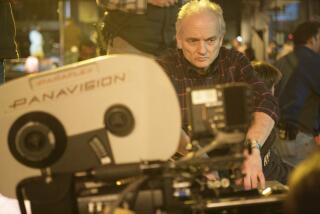How a pulp novel became a film classic
Not long ago, I saw “The Godfather” on a big screen for the first time in more than 30 years. This was a revelatory experience, not because I had forgotten anything (I hadn’t) but because it allowed me to see the film anew.
Since its release in March 1972, “The Godfather” has become an American icon, part of our cultural life. Many people, myself included, consider it the greatest movie ever made. And yet, there’s a way that this ubiquitous presence has made “The Godfather” increasingly difficult to see.
We all remember the key scenes: the horse’s head, the murder of Sollozzo and the police captain, Michael Corleone’s slow descent into a desolate corruption of the soul. What we forget, though, is the power of the story, a narrative of assimilation and identity and the compromises we make with ourselves.
Watching “The Godfather” again, uninterrupted, I was reminded of the first time I saw it, on the day it was released. I was 10, and went with my mother and my best friend. Even then, I was awed by the stately power of the storytelling. But something else struck me also: the sense that this immigrant saga was universal and that, in the tempestuous drama of the Corleones, I recognized a piece of my world.
This sense of recognition, of identification, explains the remarkable staying power of “The Godfather.” But as Jenny M. Jones reminds us in “The Annotated Godfather: The Complete Screenplay,” the film was almost never made.
Based on Mario Puzo’s bestselling 1969 novel, the project was turned down by 12 directors before Paramount executives Robert Evans and Peter Bart offered it to the then-little-known Francis Ford Coppola; he, too, originally passed, considering the material “sleazy,” according to Jones. That’s a harsh assessment -- Puzo’s novel is in fact a pretty good piece of popular fiction. There’s no question, though, that it was in the translation to the screen that “The Godfather” became, well, “The Godfather.”
Jones offers a streamlined version of the back story, highlighting the difficulties that swirled around the production. Puzo’s original screenplay was modernized at Paramount’s urging, “set in the 1970s, complete with hippies.” Coppola later dismissed that early script as “a slick, contemporary gangster picture of no importance. It wasn’t Puzo’s fault. He just did what they told him to do.” (Coppola and Puzo collaborated on two more drafts before a final script emerged.) For his part, Puzo felt “excluded from the filming,” so much so that he jokingly swore a Sicilian vendetta against Evans.
Coppola also had his issues with the production chief. “Your stupid blabbing about cutting ‘The Godfather’ comes back to me and angers me for its ridiculous pomposity. . . ,” he wrote Evans shortly after the film’s release. “You did nothing on ‘The Godfather’ other than annoy me and slow it down.”
The beauty of “The Annotated Godfather” is that it puts all this in context, while making sure we never lose sight of the most important element: the film. The bulk of the book is made up of Coppola and Puzo’s 1971 shooting script, enhanced on nearly every page by sidebar notes and details -- from the novel, production diaries and elsewhere -- that frame the screenplay in broader terms.
Jones, who works in the Film/Video Department at Minneapolis’ Walker Art Center, has an eye for minutiae; when, early in the movie, Clemenza and a couple of his men drive beneath the old Third Avenue El, she notes that filmmakers used stock footage from the 1940s and then found a car to match.
Later, she describes “the most famous technical mistake of the movie,” a missed punch in the scene where Sonny, played by James Caan, beats up his brother-in-law, Carlo, on a Harlem Street. “Coppola,” Jones writes, “laments that the gaffe was due to the film’s squeezed budget: ‘At that point we were just rushing, and it turned out that the best take had this one miss. Today they could fix it with digital effects.’ ”
It’s a great detail, not least because mistakes like this help make the film more human, and in her explication of them, Jones takes us inside the process to see the odd mix of serendipity and inspiration that resides at the center of any great work of art.
“The Annotated Godfather” makes clear that for Coppola, this sense of serendipity was essential to the making of this film. The portrait of the director that emerges is of someone at once obsessively prepared and utterly disorganized, full of ideas if not quite clear on how to make them work.
Before filming, he put together a notebook in which he annotated and took apart the actual pages of Puzo’s novel, breaking the story into 50 scenes. He then used this as a guide when filming began.
Jones reproduces several pages, including one that dissects Michael’s killing of Sollozzo: “Time stops short,” Coppola has scrawled in the margins. “Hit hard and bloody!!” There’s a single word in the upper right-hand corner of the document. “Hitchcock,” it says. What’s fascinating about this is the degree to which it suggests Coppola’s extreme self-consciousness as an artist. That sheds light on the interplay between commerce and art.
There’s little sense that Paramount knew what it had gotten into; the studio bought the rights in 1967, while Puzo, author of two well-received but weak-selling novels, was still writing. A “paltry” $12,500 option helped bankroll the completion of the book.
The initial plan was to make “a low-budget gangster movie,” but Coppola had other ideas. He fought to keep it a period piece, to shoot on location in New York and Sicily, to cast lesser-known actors and has-beens. (In the early 1970s, Marlon Brando was considered washed-up.)
He had a vision and if he couldn’t always articulate it -- “Coppola was disorganized, indecisive, and scattered,” Jones notes -- he was able to see the material as nuanced and complex. “What are they getting so excited about?” Brando asked in 1971. “It’s only another gangster picture.” Years later, however, Brando acknowledged that “it was a pretty good film,” an epic of sin and redemption and the dissolution of a family “that was in its own way,” Jones writes, “a Greek or Shakespearean tragedy.” More than anything, it’s this tragic sensibility we are left with, the idea that we’re looking at an archetypal drama. That explains our intense attachment: “Even Al Pacino,” Jones writes, “admits that, when he’s flipping the channels and comes across ‘The Godfather,’ he can’t help but keep watching.”
With “The Annotated Godfather,” Jones demystifies this connection while paying homage to all the film achieved. It’s a delicate dance, but she pulls it off, allowing us, in much the same way as my viewing of the movie, to see it fresh after all these years.
David L. Ulin is book editor of The Times.
More to Read
Only good movies
Get the Indie Focus newsletter, Mark Olsen's weekly guide to the world of cinema.
You may occasionally receive promotional content from the Los Angeles Times.











